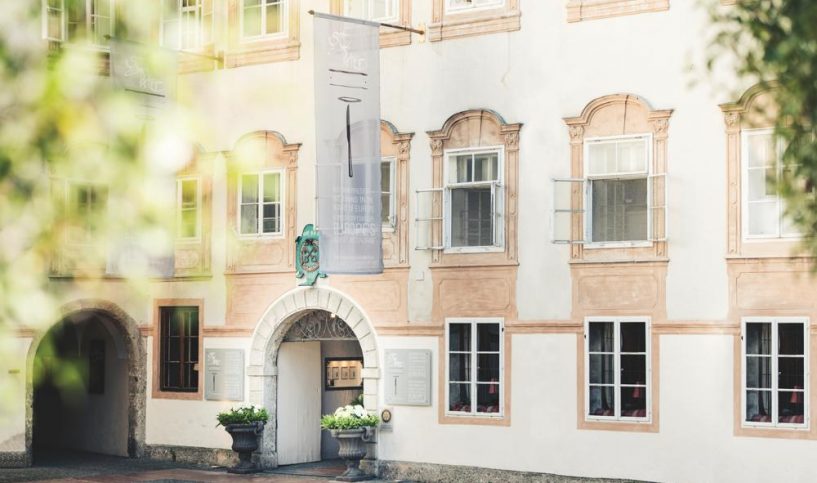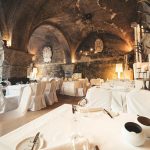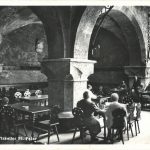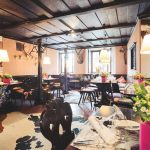I took my eyes off the map long enough to take in the sight of Residenzbrunnen, the impressive 16th century marble Baroque fountain in the center of Residenzplatz. Having just left the renowned Getreidegasse, I was standing in the town’s largest square, in awe. But there isn’t a square or a building in ‘Alstadt’ (or ‘old town’) of Salzburg, Austria that isn’t steeped in history — clearly deserving of its UNESCO World Heritage status. Henry, my Austrian friend’s voice, drifted to mind again, ‘You must visit Stiftskeller’ – and forcing me to refocus my attention on the map I was holding. It had to be somewhere here, I thought to myself, but where?
My predilection for dining in places with history, made me adamant not to leave Salzburg, without visiting St. Peter Stiftskeller — reputedly one of Europe’s oldest operating inns with over 1200 years of hospitality. Ever since Henry’s recommendation, the allure of the hostelry fueled my curiosity. Luckily, a business trip took me to Salzburg soon after, and I had the good fortune – not once, but twice – of dining at the Stiftskeller.
A friendly old gentleman resolved my predicament, and directed me straight into the spacious courtyard of St. Peter’s Archabbey. Stiftskeller, the Restaurant, is located beside the St. Peter’s Church — with the ‘onion dome’ turret — and is hard to miss. A drop-down banner and a wall panel declares it ‘Europe’s oldest restaurant’, while the shield hanging over the entrance arch bears the inscription ‘seit 803’ (since 803 AD) reinforce it. Stiftskeller used to be the “wine cellar” of the monks. The abbey itself is considered to be the oldest in the German speaking area, founded by St Rupert in 696.
Although the Guinness World Record for the oldest restaurant is held by Spain’s Botin (1725), Stiftskeller’s claim is apparently supported by a historical deed dating back to 803 AD, where it was first mentioned by Alcuin of York, an English scholar in the court of Emperor Charlemagne.
For centuries, Stiftskeller was the meeting place of princes, bishops, merchants and prominent citizens. It’s safe to say that some important historical decisions or activities, as we know today, may well have taken place within these old walls. The Mozart family once dined here; composer Michael Hayden resided on the top floor in the 1760s; and the nameless 14th century poet and songwriter, the Monk of Salzburg, gave Stiftskeller its place in literature in 1370. Even today, Stiftskeller attracts a mélange of curious tourists, famous personalities from the world of fashion, music, and sports, royalty, as well as, Salzburgers.
However, Stiftskeller’s storied past isn’t the only thing that makes it worth a visit. I was thrilled to discover that their food did not disappoint. Creative genius, Chef Andreas Krebs, cleverly blends traditional cuisine with modern expression. By the time your dish arrives at your table, it looks as impressive as anything you might expect to be served at an upscale restaurant. Stiftskeller’s menu relies on fresh Salzburg produce and seasonal fare, which means you are certain to find a new menu every time you visit.
After asking the helpful server for recommendations, my companion and I settled for onion soup and cream of carrot and ginger. While we waited for our appetizers to arrive, we were served a basket of fresh bread, which we relished hungrily with pine nut butter, colorful spreads and olive oil. The onion zuppa turned out to be very good. For our main course, we ordered duet of Salmon, which was flavorful in its simplicity, and a side of mixed salad. We capped off our dinner with coffee, and a cherry and chocolate dessert under the Salzburg night sky. But I noted that their specialty was the Salzburger Nockrel, a local pudding, as many patrons seem to order. Unfortunately, my unpleasant experience with the soufflé in a café in Getreidegasse, refrained me from attempting to eat another.
My second visit, was sadly a brief one, but nonetheless enchanting. The kitchen had already served its last order, leaving us with only two viable choices: drinks and desserts. With the late-March weather still pretty cold, we headed inside, and seated ourselves beneath the framed picture of Peter Klotz, abbot of St. Peter, and whose picture must have been hanging in the same place since the 1930s. Between sips of hot Espressos, we enjoyed a generous serving of Crème Brûlée and Apple Strudel, a Grandma’s recipe with vanilla ice cream. One of my companions declared it the very best he had ever tasted.
The restaurant has various dining options. A brick cellar, a parlor, an enclosed open-air courtyard, and several elegantly decorated dining rooms on the upper levels, with a capacity to accommodate up to 700 guests. I preferred the courtyard to the closed, and a little stuffy, parlor. When I first dined there in 2013, the Wilibaldhohle and the open-air courtyard had just been redesigned. Under the old stone arcade, tables and chairs were covered in pristine white giving it a cozy ambience. Overall, it’s a classic marriage of an old structure and modern décor – a clever move by its current hosts.
One of the highlights of dining at the Stiftskeller is the Mozart Dinner Concert. Debuted in 1996, it is held every evening in the elegant Baroque Hall on the top level, and is an elaborate affair, complete with period-dressed servers, performance of Mozart’s compositions, and a menu adapted from 18th century recipes. The now refurbished hall was originally built in 1903. Although I did not have the chance to try it out, I’ve heard good reviews and it sounds interesting.
Salzburg ranks amongst Europe’s loveliest cities, especially, the historic ‘old town’ and features in every traveler’s European tour. And whether you are on business, honeymooning, or just visiting the city for its famed beauty, the Stiftskeller is easily a dining delight. I consider, and recommend, it a Salzburg special.
If you are ever in Austria, you can find Stiftskeller at St. Peter Bezirk 1/4, 5020 Salzburg, Austria. For more information about Europe’s oldest restaurant, visit www.stpeter-stiftskeller.at.
Images courtesy: St. Peter Stiftskeller















